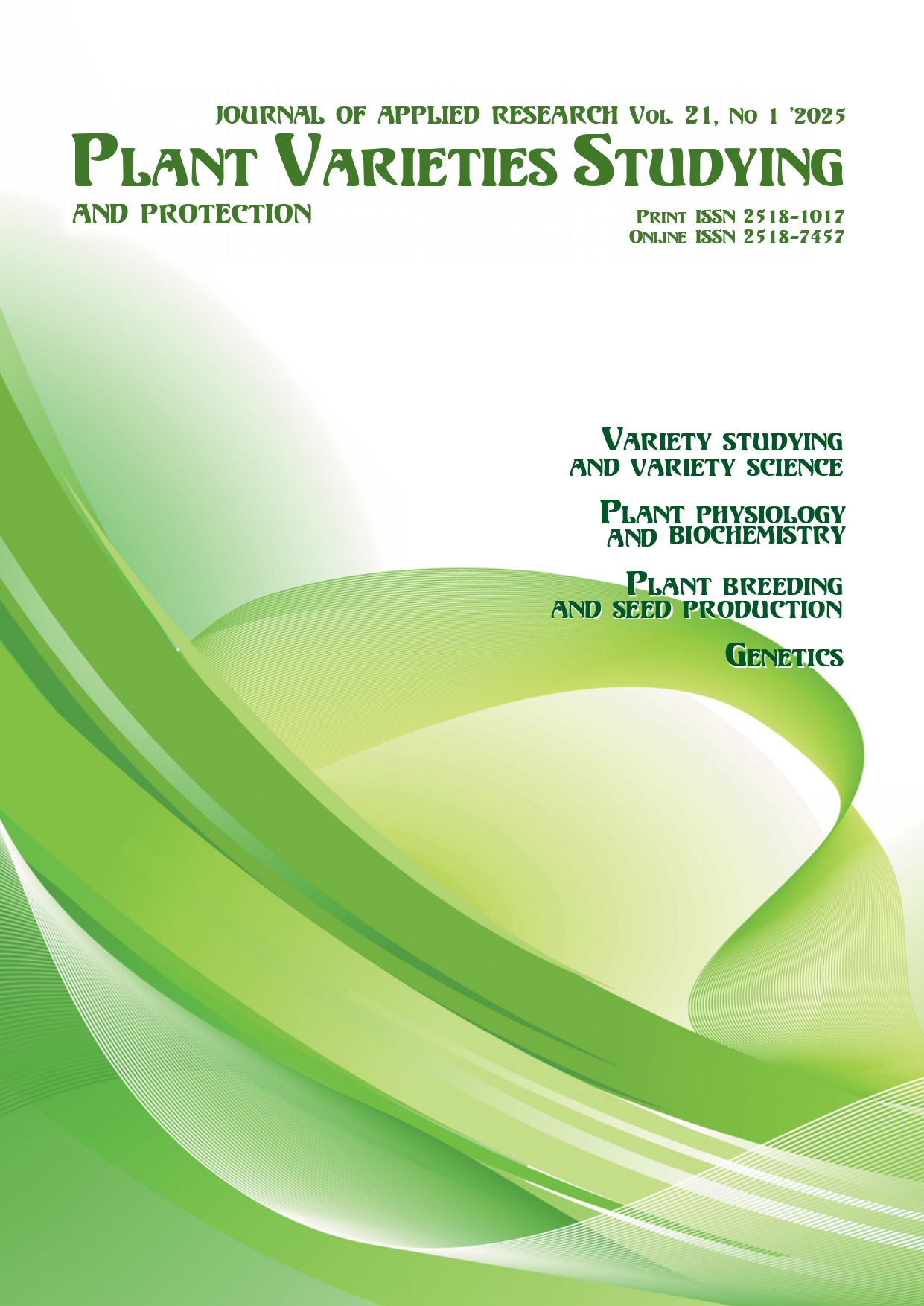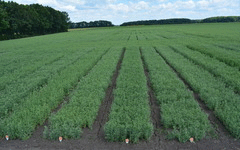Combinational ability of varieties and self-pollinated lines of industrial hemp for seed and oil use in the topcross system
DOI:
https://doi.org/10.21498/2518-1017.21.1.2025.327500Keywords:
Cannabis sativa L., breeding, hybrid, total and specific combining ability, productivity, heterosis, additive effects of genes, non-additive effects of genesAbstract
Purpose. To determine the peculiarities of total combining ability (TCA) and variances specific combining ability (SCA) effects of maternal components and test varieties of intervarietal and linear-varietal hybrids of monoecious hemp on the basis of seed productivity and oil content, to determine the predominance of additive or non-additive gene effects and to identify components with the highest breeding value, to give a forecast of the effectiveness of selection in hybrid populations. Methods. Combining ability was determined in the system of complete topcrosses. The varieties ‘YUSO 31’, ‘Demetra’, ‘Artemida’, ‘Aphrodita’, ‘Harmoniia’, ‘Hlesiia’, ‘Hlukhivski 33’, ‘Hlukhivski 51’ and their self-pollinated lines of the fourth generation were used as maternal forms, which were crossed with three test varieties ‘Hliana’, ‘Aphina’ and ‘Mykolaichyk’ (48 hybrid variants in total). The results of measurements were interpreted by arithmetic mean, F-test (R. A. Fisher), least significant difference and ranked. Results. The study of hemp varieties and their self-pollinated lines by the parameters of combining ability as maternal components of crosses showed significant differentiation by the effects of TCA (from −22.60 to 21.40 by inflorescence length, from −10.35 to 15.15 by seed weight, from −3.91 to 3.23 by thousand seed weight, from −2.40 to 3.76 by oil content) and SCA variances (6.72–233.23; 3.25–78.29; 0.01–0.10 and 0.01–2.10, respectively). The highest SCA was observed in the maternal forms of ‘Aphrodita’, I4 ‘Aphrodita’, I4 ‘Demetra’ and I4 ’Hlukhivski 51’ and the tester variety ‘Aphina’. A comparison of the effects of TCA and SCA variances revealed that the ‘Aphrodita’ variety and its self-pollinated line I4 were the best crossing components. Conclusions. In the analysed crosses, the additive effects of genes prevail in terms of thousand-seed weight and oil content, indicating the feasibility of selecting for phenotype. In contrast, non-additive effects prevail in terms of inflorescence length and seed weight, indicating the need for genotype selection. To increase seed productivity and oil content through combination breeding, it is advisable to use linear-varietal crosses where the maternal components have either high TCA and high SCA or medium TCA and high SCA.
Downloads
References
Tănase Apetroaei, V., Pricop, E. M., Istrati, D. I., & Vizireanu, C. (2024). Hemp seeds (Cannabis sativa L.) as a valuable source of natural ingredients for functional foods – A review. Molecules, 29(9), Article 2097. https://doi.org/10.3390/molecules29092097
 |
| 
Mishchenko, S. V., & Mokher, Yu. V. (Eds.). (2024). Scientific support for the development of hemp cultivation in the 21st century. FOP Tsoma S. P. https://doi.org/10.48096/monograph.2024 [In Ukrainian]
Muangrat, R., & Kaikonjanat, A. (2025). Comparative evaluation of hemp seed oil yield and physicochemical properties using supercritical CO2, accelerated hexane, and screw press extraction techniques. Journal of Agriculture and Food Research, 19, Article 101618. https://doi.org/10.1016/j.jafr.2024.101618

Struk, O., Grytsyk, A., Mikitin, M., Obodianskyi, M., Stasiv, T., & Svirska, S. (2022). Research of biologically active substances of hemp seeds, hemp seed oil and hemp pomace. ScienceRise: Pharmaceutical Science, 5(39), 46–54. https://doi.org/10.15587/2519-4852.2022.241249

Eržen, M., Čeh, B., Kolenc, Z., Bosancic, B., & Čerenak, A. (2023). Evaluation of different hemp (Cannabis sativa L.) progenies resulting from crosses with focus on oil content and seed yield. Industrial Crops and Products, 201, Article 116893. https://doi.org/10.1016/j.indcrop.2023.116893

Gudi, S., M, P., Alagappan, P., Raigar, O. P., Halladakeri, P., Gowda, R. S. R., Kumar, P., Singh, G., Tamta, M., Susmitha, P., Amandeep, & Saini, D. K. (2024). (2024). Fashion meets science: How advanced breeding approaches could revolutionize the textile industry. Critical Reviews in Biotechnology, 44(8), 1653–1679. https://doi.org/10.1080/07388551.2024.2314309
 |
| 
McLeod, A., Contreras, R., Halstead, M., & Vining, K. (2023). In vivo and in vitro chromosome doubling of ‘I3’ hemp. HortScience, 58(9), 1018–1022. https://doi.org/10.21273/HORTSCI17169-23

Halstead, M. A., Garfinkel, A. R., Marcus, T. C., Hayes, P. M., & Carrijo, D. R. (2022). Hemp growth in vitro and in vivo: A comparison of growing media and growing environments across 10 accessions. HortScience, 57(9), 1041–1047. https://doi.org/10.21273/HORTSCI16651-22

Priyadarshan, P. M. (2019). Plant breeding: Classical to modern. Springer. https://doi.org/10.1007/978-981-13-7095-3

Campbell, B. J., Berrada, A. F., Hudalla,C., Amaducci, S., & McKay, J. K. (2019). Genotype × environment interactions of industrial hemp cultivars highlight diverse responses to environmental factors. Agrosystems, Geosciences & Environment, 2(1), Article 180057. https://doi.org/10.2134/age2018.11.0057

Ferfuia, C., Zuliani, F., Danuso, F., Piani, B., Cattivello, C., Dorigo, G., & Baldini, M. (2021). Performance and stability of different monoecious hemp cultivars in a multienvironments trial in North-Eastern Italy. Agronomy, 11(7), Article 1424. https://doi.org/10.3390/agronomy11071424

Tsaliki, E., Kalivas, A., Jankauskiene, Z., Irakli, M., Cook, C., Grigoriadis, I., Panoras, I., Vasilakoglou, I., & Dhima, K. (2021). Fibre and seed productivity of industrial hemp (Cannabis sativa L.) varieties under Mediterranean conditions. Agronomy, 11(1), Article 171. https://doi.org/10.3390/agronomy11010171

Ferfuia, C., Fantin, N., Piani, B., Zuliani, F., & Baldini, M. (2024). Seed growth and oil accumulation in two different varieties of industrial hemp (Cannabis sativa L.). Industrial Crops and Products, 216, Article 118723. https://doi.org/10.1016/j.indcrop.2024.118723

Litun, P. P., & Proskurnin, M. V. (1992). Genetics of quantitative traits. Genetic crosses and genetic analysis. Uchbovo-metodychnyi kabinet vyshchoi osvity. [In Ukrainian]
Chetverik, O. O., Zvyagin, A. F., & Kozachenko, M. R. (2014). Combining ability of soft winter wheat varieties by plant traits in F1 hybrids in topcross system. Plant Breeding and Seed Production, 105, 85–92. https://doi.org/10.30835/2413-7510.2014.42058 [In Ukrainian]
Klimova, O. E. (2014). Differentiation reсombinant line of the sweet corn on parameter of the combinational ability. Plant Breeding and Seed Production, 106, 111–120. https://doi.org/10.30835/2413-7510.2014.42136 [In Ukrainian]
Trush, S. G., Parfeniuk, O. O., Balanіuk, L. O., & Tatarchuk, V. M. (2023). Inheritance regularities of economic and valuable traits in selection of sugar beet simple cytoplasmic male sterile hybrids. Agriculture and Plant Sciences: Theory and Practice, 3(9), 105–113. https://doi.org/10.54651/agri.2023.03.12 [In Ukrainian]
Mishchenko, S. V. (2017). Effects of total and variances of specific combining ability of hemp inbred lines and varieties in topcross system. Factors in Experimental Evolution of Organisms, 21, 62–67. https://doi.org/10.7124/FEEO.v21.808 [In Ukrainian]
Mishchenko, S. V., Laiko, I. M., & Kyrychenko, H. I. (2021). Breeding of industrial hemp with a high content of cannabigerol by the case of ‘Vik 2020’ cultivar. Plant Varieties Studying and Protection, 17(2), 105–112. https://doi.org/10.21498/2518-1017.17.2.2021.236514
Salentijn, E. M. J., Petit, J., & Trindade L. M. (2019). The complex interactions between flowering behavior and fiber quality in hemp. Frontiers in Plant Science, 10, Article 614. https://doi.org/10.3389/fpls.2019.00614
 |
| 
Published
How to Cite
Issue
Section
License
Copyright (c) 2025 S. V. Mishchenko, V. M. Kabanets, H. I. Kyrychenko, T. Yu. Marchenko, H. M. Laiko

This work is licensed under a Creative Commons Attribution-ShareAlike 4.0 International License.
Starting in 2022, the copyright to the publication remains with the authors
Our journal abides by the CREATIVE COMMONS copyright rights and permissions for open access journals.
Authors, who are published in this journal, agree to the following conditions:
- The authors reserve the right to authorship of the work and pass the first publication right of this work to the journal under the terms of a Creative Commons Attribution License, which allows others to freely distribute the published research with the obligatory reference to the authors of the original work and the first publication of the work in this journal.
- The authors have the right to conclude separate supplement agreements that relate to non-exclusive work distribution in the form in which it has been published by the journal (for example, to upload the work to the online storage of the journal or publish it as part of a monograph), provided that the reference to the first publication of the work in this journal is included.

























 Ukrainian Institute for Plant Varieties Examination
Ukrainian Institute for Plant Varieties Examination  Селекційно-генетичний інститут
Селекційно-генетичний інститут Institute of Plant Physiology and Genetics of the National Academy of Sciences of Ukraine
Institute of Plant Physiology and Genetics of the National Academy of Sciences of Ukraine
 The National Academy of Agrarian Sciences of Ukraine
The National Academy of Agrarian Sciences of Ukraine